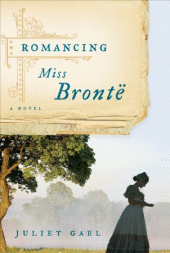In today's post, guest blogger and author Juliet Gael talks about her ongoing fascination with the Brontës and how she came to write about them in her new novel ROMANCING MISS BRONTE.
 My fascination with the Brontës began fifteen years ago when I took a graduate level seminar devoted exclusively to the novels of the three sisters. During my research, I began to understand to what degree their novels were grounded in a profoundly complex psychology and equally complex family dynamics. The interaction between the sisters and their gifted and brilliant father and brother recalled some of the fundamental themes of Sandra Gilbert and Susan Gubar’s feminist classic The Madwoman in the Attic and Elaine Showalter’s A Literature of Their Own, studies I had read years before during my graduate work in French and which ranked at the top of my personal feminist canons. The secrecy of women’s lives, the troubled relationship with a dominant father both resented and revered, the daughters’ struggle for recognition in a patriarchal society, these themes played out inside an isolated parsonage in the bleak Yorkshire moors were the stuff of powerful fiction.
My fascination with the Brontës began fifteen years ago when I took a graduate level seminar devoted exclusively to the novels of the three sisters. During my research, I began to understand to what degree their novels were grounded in a profoundly complex psychology and equally complex family dynamics. The interaction between the sisters and their gifted and brilliant father and brother recalled some of the fundamental themes of Sandra Gilbert and Susan Gubar’s feminist classic The Madwoman in the Attic and Elaine Showalter’s A Literature of Their Own, studies I had read years before during my graduate work in French and which ranked at the top of my personal feminist canons. The secrecy of women’s lives, the troubled relationship with a dominant father both resented and revered, the daughters’ struggle for recognition in a patriarchal society, these themes played out inside an isolated parsonage in the bleak Yorkshire moors were the stuff of powerful fiction.
Not long afterwards, I had the opportunity to travel to Yorkshire with my eight-year-old daughter. We stayed in a weaver’s cottage in Haworth and hiked far into the heathery moorland. We ate our picnic lunch on the windswept tops near the derelict farmhouse that legend says inspired Wuthering Heights and fell asleep in the warm sun on a grassy knoll amidst the ruins. That first visit ranks as the most memorable of all the pilgrimages I have made to Haworth. On our last visit, my daughter was twenty and had grown decidedly less compliant and less tolerant of her mother’s fascination with the Brontës and their moors. After an hour slogging through the desolate wintry hills in stinging hail driven by a wind so powerful it felt like needles on our exposed faces, she got fed up with me and stormed back to the village. I reluctantly followed.
At the time I had been working in film and my initial response was to write the story as a screenplay. I confess my first efforts must have left producers scratching their heads. London-based David Putnam – who had been executive producer at Sony Pictures on a previous project where I had been the screenwriter – was the target of numerous unorthodox attempts to pitch the unwieldy story. Before the days of PowerPoint, I took a roll of butcher’s paper, created a sprawling twenty-foot-long color-coordinated timeline taking the family through all their heartaches and tragedies from childhood to death, dropped it into a mailing tube and shipped it off to his London production company. “Just lay it on a table and unroll it!” I pleaded over the telephone to his development executive. “It’s such a poignant heart-wrenching story!” They were kind enough to return the tube to me some months later; as I recall it had never been opened.
I began to hone in on the elements of what I felt constituted a central drama: the triangle of Charlotte, her father, and Arthur Nicholls, the man who – in the face of obstacles that would have daunted the most love-sick hero – persisted, prevailed and won her heart. It was a kind of David and Goliath story – the unappreciated and misunderstood Arthur Nicholls about whom very little is known, the man whom feminist academics accuse of throttling her creativity – succeeding against all odds. His love for Charlotte would be the narrative engine that moved the story along, throughout the writing of the sisters’ novels and the tragedies that followed.
Over the years other projects intervened, but the Bronte story continued to haunt me. Long time friend and London editor Barbara Daniel supplied the spark of encouragement. “Just write it,” she said. “You feel so strongly about it. Just do it.”
“So be it,” I thought. “Whether it ever gets published or not, I’ll have told the story in my own way. I’ll have exorcised my demons.”
The Brontës and the major pivotal incidents of their lives as portrayed in the novel are rooted in actual events. I found myself ignoring many of the legendary anecdotes; instead, I trawled through fine-print footnotes reading between the lines, looking for details that might expand my understanding of how they went about their lives. It was here that my imagination often found its inspiration, in the possibility of what might have happened. That’s the way fiction writers work. Charlotte would have understood this; in the context of our hugely different contemporary culture, I think she would have approved.
-- Juliet Gael, Author

